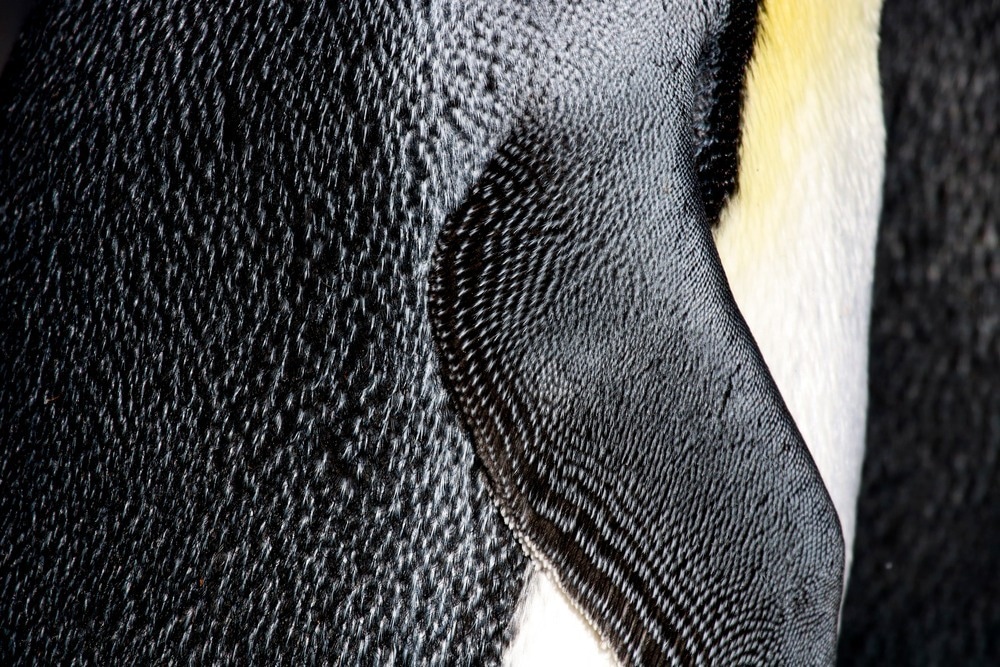The two distinct challenges of ice build-up: water adherence and ice adherence, are often conflated in anti-icing nano surface studies. Penguin feathers are excellent natural examples of anti-icing nano surfaces. As remarkable anti-icing strategies, these feathers use two distinct mitigation mechanisms, namely water-shedding and ice-shedding.

Study: Robust Anti-Icing Surfaces Based on Dual Functionality─Microstructurally-Induced Ice Shedding with Superimposed Nanostructurally-Enhanced Water Shedding. Image Credit: ValerieVSBN/Shutterstock.com
A recent study published in the journal ACS Applied Materials & Interfaces imitates the wire-like microstructure of penguin plumes, which are adorned with overlaying nano grooves by laser machining finely woven wire fabrics for innovative anti-icing applications.
Anti-icing Technologies: Overview and Significance
Ice accumulation on exterior structures has been a recurrent technical obstacle in many industrial applications. The formation of ice on outdoor structures varies from an annoyance to a hazard. Due to an excessive accumulation of ice, solar cells lose their transmittance, concrete roads and sidewalks lose adhesion, power transfer cables collapse under the excessive weight, and wings lose their lifting ability.
In recent years, much effort has been devoted to creating surfaces that passively hinder the accumulation of surface ice. These anti-icing tactics addressed in the literature may be divided roughly into those that attempt to stop ice production (water-shedding) and those that aim to reduce the bonding strength of ice (ice-shedding).
There is limited overlap between water-shedding and ice-shedding nano-surface engineering solutions. On the one side, surfaces may be designed to reject water droplets by decorating them with air-trapping nanostructures and advantageous surface composition. Thus, the contact period between water and solids is minimized, avoiding the development of ice.
On the other hand, superhydrophobicity is reduced in cold, humid environments when water droplets adsorb into the tiny roughness characteristics of the nano surface irrespective of their fundamental hydrophilicity. This lack of superhydrophobicity results in a significant rise in ice bonding strength.
Challenges Associated with Current Anti-icing Technologies
Numerous studies have investigated using flat nano surfaces with low-energy coverings to minimize ice adhesion by lowering thermal adhesion and reducing interlocking influences. However, there seems to be a lower bound ice adhesion strength of roughly 150 kPa for nano surfaces created in this fashion, far more than the 20 kPa barrier for the passive elimination of ice.
These low-energy nano coatings also depend on harsh chemistries and exhibit a lack of resilience. Frequent icing/de-icing cycles harm the low surface nano coatings, resulting in an ultimate loss of anti-icing capacity.
Relevant studies have indicated that the introduction of contact fractures is important for building ice-shedding nano surfaces instead of surface energy management. Particularly, it has been shown that a strong ice-shedding coating can be created by bare metal, provided one incorporates crack growth considerations in its design.
However, creating a surface that incorporates both the avoidance of ice formation and the decrease of ice bonding strength with minimal continuous energy contributions has proven to be a difficult issue.
Penguin Feathers: An Inspiration for Effective Anti-icing Technologies
Penguin feathers are an excellent example of naturally occurring anti-icing technologies. These birds are rarely observed to carry snow or ice despite their hunting in frigid waters at temperatures much less than 0 °C.
It is possible that the nanostructure of the penguin's body feather, which resembles a bent wire, promotes the shedding of ice by inducing interfacial fissures. It is unclear, however, what effect the directed nano grooves play in ice-substrate contact breakage.
Inspired by the anti-icing properties of penguin feathers, the current study examines the innovative combination of separate water-shedding and ice-shedding design methodologies to create a sustainable, durable nano surface with passive anti-icing functionalization. The research also describes the importance of nano grooves in boosting the anti-icing performance of the as-prepared nano surfaces.
"We found that the hierarchical arrangement of the feathers themselves provides water-shedding qualities, while their barbed surfaces lower the adhesion of ice," explains Michael Wood, one of the Co-Authors of the current study. "We were able to replicate these combined effects through a laser-machined woven wire mesh."
Important Findings of the Current Study
Wind-tunnel tests of surfaces coated by the as-prepared steel mesh revealed that the nano coating was 95% more successful at preventing ice accumulation than a sheet of brushed stainless steel without an encapsulation. The additional nanostructuring and surface composition confer a water-repellent property to the coating, As evidenced by goniometry and high-velocity droplet impact tests.
This novel technology using nature-inspired nano surfaces offers a maintenance-free solution to ice formation on wind turbines, electric towers, power grids, and aircraft since there are no chemical treatments needed. Moreover, multiple icing/de-icing cycles did not affect the hydrophilicity of the as-prepared nano coatings.
More from AZoNano: Graphene Could Help Meet Net Zero Goals: Here's How
Reference
Wood, M. J. et al. (2022). Robust Anti-Icing Surfaces Based on Dual Functionality─Microstructurally-Induced Ice Shedding with Superimposed Nanostructurally-Enhanced Water Shedding. ACS Applied Materials & Interfaces. Available at: https://doi.org/10.1021/acsami.2c16972
Disclaimer: The views expressed here are those of the author expressed in their private capacity and do not necessarily represent the views of AZoM.com Limited T/A AZoNetwork the owner and operator of this website. This disclaimer forms part of the Terms and conditions of use of this website.